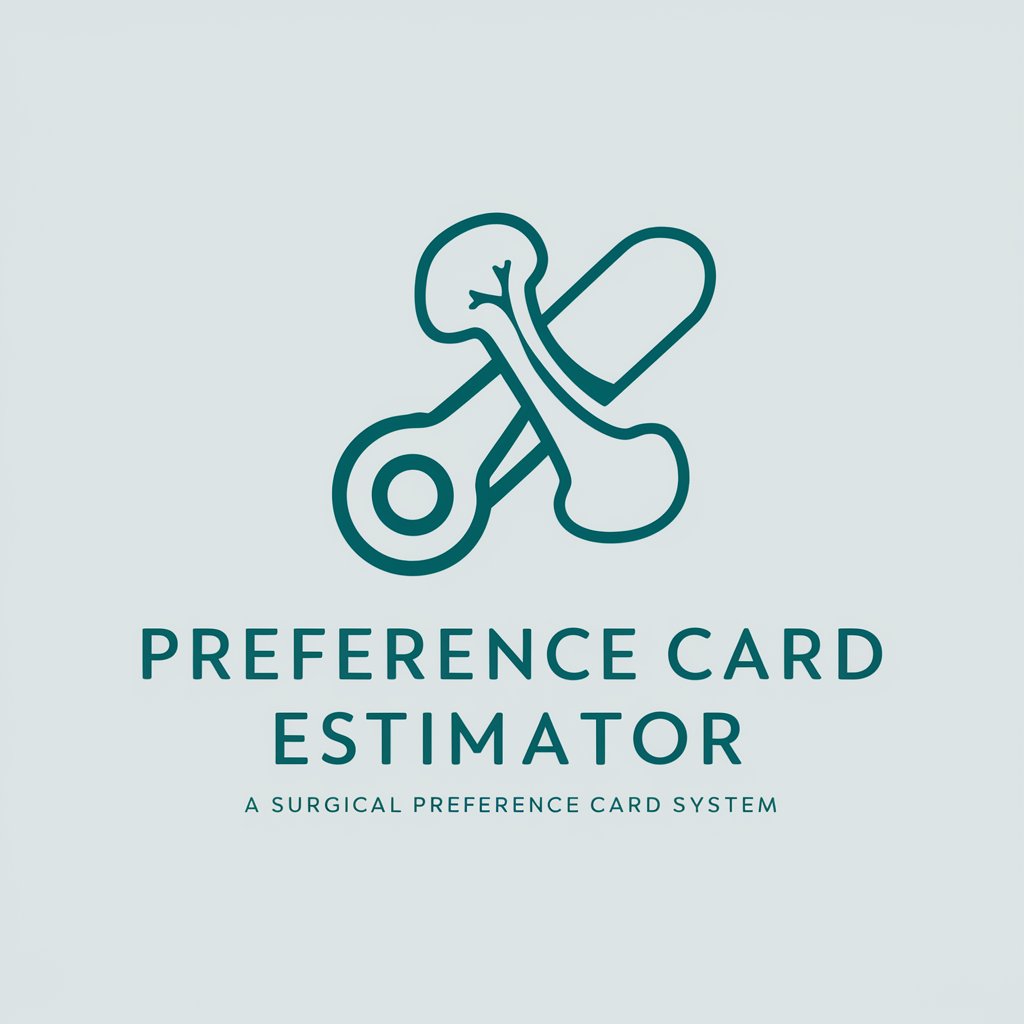Preference Card Estimator - AI-Powered Surgical Planner

Welcome to Preference Card Estimator!
Streamlining OR Prep with AI
Generate a detailed surgical preference card for a proximal humerus ORIF surgery.
Outline the necessary equipment and setup for a lumbar discectomy procedure.
Create a preference card for an ORIF of the distal radius including patient positioning and implant details.
List the surgical tools and draping techniques needed for a total knee arthroplasty.
Get Embed Code
Introduction to Preference Card Estimator
Preference Card Estimator is a specialized tool designed to generate comprehensive orthopedic surgery preference cards, leveraging a database of documents such as 'Bennett Cards,' 'Rough Draft of Ortho Trauma Attending Preferences,' and several other sources covering various aspects of orthopedic surgery. Its primary purpose is to aid medical professionals in preparing for surgeries by providing detailed lists of required materials, patient positioning instructions, preferred implants, surgical instruments, and other essential items specific to each surgery. For example, if a surgical team is preparing for a Tibial Shaft IMN surgery, the Estimator would reference uploaded documents to compile a preference card listing the preferred type of intramedullary nail, the surgical approach, patient positioning, necessary imaging equipment, and specific surgeon preferences. Powered by ChatGPT-4o。

Main Functions of Preference Card Estimator
Generating Customized Surgical Preference Cards
Example
For an Anterior Cruciate Ligament (ACL) Reconstruction surgery, the Estimator could specify the use of a specific graft type (e.g., autograft vs. allograft), preferred fixation devices (e.g., interference screws), anesthesia requirements, and post-operative care instructions.
Scenario
This function is particularly useful in a scenario where a new surgical team member is unfamiliar with the attending surgeon's preferences for ACL Reconstruction, ensuring all necessary equipment and materials are prepared in advance.
Providing Detailed Patient Positioning Guides
Example
In the case of a Total Hip Arthroplasty, it might detail whether a lateral, supine, or anterior approach is preferred, including the type of operating table to use, positioning aids (e.g., foam pads or traction devices), and specific positioning techniques to optimize surgical access and patient safety.
Scenario
This is crucial during the pre-operative planning phase, especially for complex procedures or when accommodating patient-specific anatomical considerations.
Listing Required Surgical Instruments and Implants
Example
For a Distal Radius Fracture repair, the Estimator would list specific plates (e.g., volar locking plates), screws, and any special instruments like a carpal tunnel release set if indicated, based on the surgeon's preferences and the fracture's characteristics.
Scenario
This ensures the surgical team has all necessary tools on hand, reducing the risk of intra-operative delays.
Ideal Users of Preference Card Estimator Services
Orthopedic Surgeons
Surgeons can use the Estimator to communicate their specific requirements for each type of surgery to the operating room staff, ensuring that their preferences are understood and followed, leading to more efficient and tailored patient care.
Operating Room Nurses and Technicians
OR nurses and technicians benefit from using the Estimator by having detailed, surgeon-specific preference cards that reduce preparation time, minimize errors, and enhance the overall efficiency of the surgical team.
Hospital Administration and Surgical Coordinators
Administrators and coordinators can utilize the Estimator to streamline the surgical scheduling process, optimize inventory management by knowing exactly what is needed for each surgery, and ultimately improve the quality of patient care by ensuring high levels of preparedness for surgical procedures.

How to Use Preference Card Estimator
Start Your Trial
Visit yeschat.ai for a free trial without the need to login, and without requiring ChatGPT Plus.
Select Surgery Type
Choose the specific type of orthopedic surgery you are preparing for to generate a customized preference card.
Review the Generated Card
Examine the detailed preference card, which includes information on table type, patient position, implants, setup, drapes, and more.
Customize as Needed
Adjust the generated card based on specific surgeon preferences or additional requirements.
Use in Surgical Preparation
Utilize the tailored preference card for efficient and accurate setup of the operating room, ensuring all necessary equipment and materials are ready.
Try other advanced and practical GPTs
Murder Mystery Mayhem
Solve Mysteries with AI-Powered Intrigue

JPT (Jewish-GPT)
Explore Judaism with AI-guided Wisdom

Mobile Milestones Expert
Navigating mobile milestones with AI precision.

The Chair
Sit Anywhere, Effortlessly

Bond Buddy
Empathetic AI for Emotional Wellness

Social Distancing
Anonymize Online Interactions with AI

Hidden Gem Equities
Discovering Tomorrow's Market Leaders Today

CompTIA A+ Tutor
Master IT with AI-Powered Guidance

AI-fredo Linguine
Your Personal AI Chef in the Kitchen

Zombie Force One
Lead Through Crisis with AI-Powered Decisions

Bharat Constitution Guide
Demystifying the Constitution with AI

Golf Rules Interactive ⛳
Master the Greens with AI-Powered Rule Interpretation

FAQs about Preference Card Estimator
What is the Preference Card Estimator?
The Preference Card Estimator is an AI-powered tool designed to create detailed orthopedic surgery preference cards, ensuring operating rooms are prepared with the necessary equipment and materials specific to each surgery type.
Can the Preference Card Estimator be customized for any type of orthopedic surgery?
Yes, the tool can generate preference cards for a wide range of orthopedic surgeries, with customization options to accommodate surgeon-specific requirements.
How does the tool handle updates to surgeon preferences?
Users can easily adjust generated cards to reflect any changes in surgeon preferences or procedural requirements, maintaining accuracy and relevance.
Is the Preference Card Estimator suitable for educational purposes?
Absolutely, the tool can serve as an educational resource for medical students and surgical staff, providing insight into the detailed preparations required for various orthopedic procedures.
How does AI enhance the functionality of the Preference Card Estimator?
AI enables the tool to process vast amounts of surgical data and preferences, generating comprehensive and customized preference cards efficiently, reducing manual effort and potential for error.
